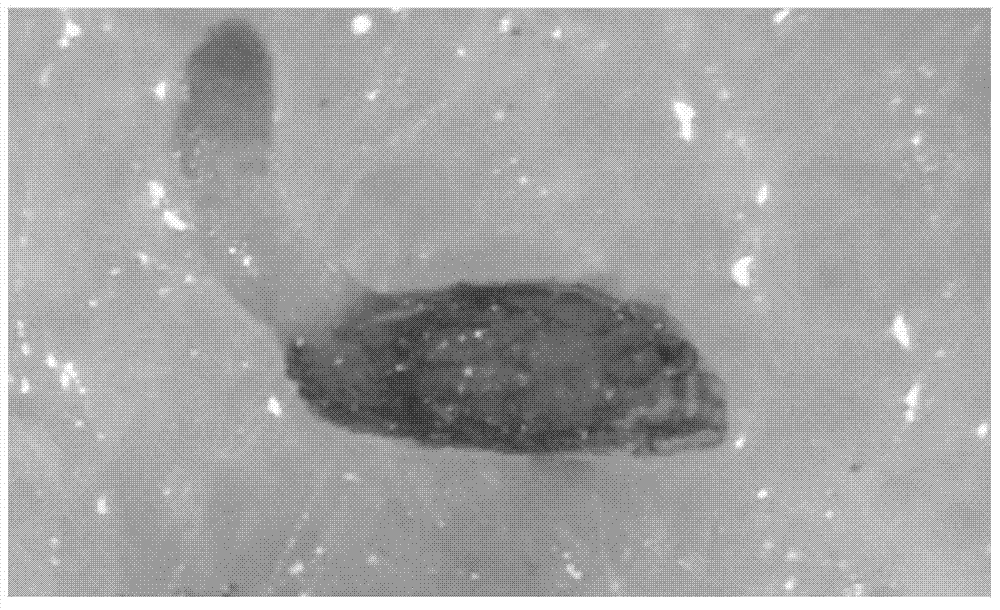Method for rapid screening of parasitic weed sensitive herbicide
A herbicide and sensitivity technology, applied in the field of rapid herbicide screening, can solve the problems of crop environmental damage, indiscriminate use of herbicides, differences in resistance of different crops, etc., to avoid water loss, prevent bacterial contamination, and eliminate false positive results. Effect
- Summary
- Abstract
- Description
- Claims
- Application Information
AI Technical Summary
Problems solved by technology
Method used
Image
Examples
Embodiment 148
[0041] The control effect test of embodiment 148% Zhongbutaline EC to sunflower row when (Orobanche cumana Wallr)
[0042] ⑴Reagent preparation
[0043] ① Disinfectant preparation, in 100ml: 20ml of 5% sodium hypochlorite stock solution plus 30ml sterile distilled water to dilute into 2% sodium hypochlorite solution, 0.1g of Tween-20 plus 49.9ml of sterile distilled
[0044] ②10 -6 M GR24 solution preparation, take 3mg solid GR24 dissolved in acetone and dilute to 10ml to form 10 -3 M's GR24 mother solution, take 10μl of the mother solution and add sterile distilled water to 10ml to make 10 -6 The GR24 solution of M was sterilized by filtration with a 0.22 μm filter membrane;
[0045] ③Preparation of herbicide solution, take 1.2μl 48% Zhongbuling EC dissolved in 1.5ml sterile distilled water to make 600mg / m 2 The herbicide solution was diluted 10 times and 100 times respectively to form 600mg / m 2 、60mg / m 2 、6mg / m 2 Concentration gradient, sterilized by filtration with a...
Embodiment 296
[0055] Embodiment 296% Jinduer EC is to the control effect test of Orobanche minor (Orobanche minor)
[0056] ⑴Reagent preparation:
[0057] ① Disinfectant solution preparation, in 100ml: 20ml of 5% sodium hypochlorite stock solution plus 30ml sterile distilled water to dilute into 2% sodium hypochlorite solution, 0.1g of Tween-20 plus 49.9ml sterile distilled water to make a 0.2% solution, mix the two The solution is mixed to make a disinfectant;
[0058] ②10 -6 M GR24 solution preparation, take 3mg solid GR24 dissolved in acetone and dilute to 10ml to form 10 -3 M's GR24 mother solution, take 10μl of the mother solution and add sterile distilled water to 10ml to make 10 -6 The GR24 solution of M was sterilized by filtration with a 0.22 μm filter membrane;
[0059] ③ Herbicide solution preparation, take 0.73μl 96% Jinduer EC dissolved in 1.5ml sterile distilled water to make 375mg / m 2 The herbicide solution was diluted 10 times and 100 times respectively to form 375mg / m ...
PUM
 Login to View More
Login to View More Abstract
Description
Claims
Application Information
 Login to View More
Login to View More - R&D
- Intellectual Property
- Life Sciences
- Materials
- Tech Scout
- Unparalleled Data Quality
- Higher Quality Content
- 60% Fewer Hallucinations
Browse by: Latest US Patents, China's latest patents, Technical Efficacy Thesaurus, Application Domain, Technology Topic, Popular Technical Reports.
© 2025 PatSnap. All rights reserved.Legal|Privacy policy|Modern Slavery Act Transparency Statement|Sitemap|About US| Contact US: help@patsnap.com


